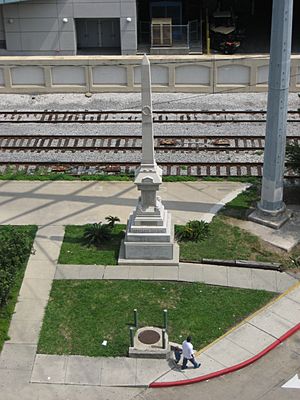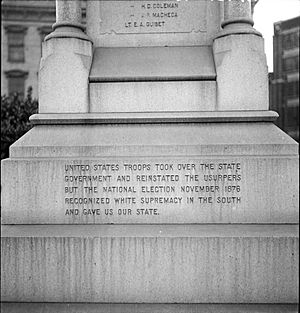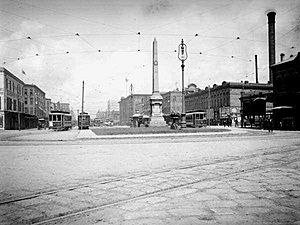Battle of Liberty Place Monument facts for kids

The monument in 2006, before it was moved to storage.
|
|
| Location | New Orleans, Louisiana, U.S. |
|---|---|
| Completion date | 1891 |
| Dismantled date | April 24, 2017 |
The Battle of Liberty Place Monument was a tall stone pillar, called an obelisk, that used to be in New Orleans, Louisiana. It was built to remember an event called the "Battle of Liberty Place" in 1874. During this event, a group called the White League tried to take control of the Louisiana government. They wanted to remove the Republican leaders who were in charge after the Civil War.
This monument was put up in 1891 by the city government, which was mostly made up of white leaders. Over time, it became a place for protests. Some people supported it as a symbol of their beliefs, while others strongly disagreed with it because they saw it as a symbol of unfairness and racism. In 2017, after a lot of debate and concerns about safety, the monument was taken down and put away in storage.
What Led to the Battle?
The election for governor in Louisiana in 1872 was very close and caused a lot of arguments. Two main candidates were John McEnery from the Democratic Party and William Pitt Kellogg from the Republican Party. Kellogg was announced as the winner.
However, McEnery and his supporters did not agree with this result. They believed he should have won. In 1874, they even set up their own separate government. In September 1874, a group called the White League came into New Orleans, which was the state capital at the time. Their goal was to force Governor Kellogg out of office.
On September 19, they fought against the city and state police in what became known as the Battle of Liberty Place. The White League won this fight and took over government buildings. They left after President Ulysses S. Grant sent federal troops to the city to restore order.
History of the Monument
In 1891, the New Orleans city government decided to build the Liberty Monument. This was around the same time that new laws were being passed that made it harder for many Black Americans to vote. The monument was meant to celebrate the 1874 uprising. It was placed in a very noticeable spot on Canal Street. In 1932, more words were added to the monument. These new words said that the battle helped establish the idea of "white supremacy," which is the belief that white people are superior to other races.
Over time, especially after the Civil Rights Movement, many people in New Orleans, particularly Black residents, felt that the monument was a symbol of racism and unfairness. They wanted it removed.
In 1965, the monument was taken down for a short time because of construction work. When it was put back up in 1970, many people protested. It was often vandalized, meaning people would damage it or write on it.
In 1974, the city added a new plaque near the monument. This plaque explained the history but also said that the city no longer agreed with the old ideas of racial superiority.
In 1976, a youth group from the NAACP officially asked for the monument to be removed. Groups that supported racist ideas, like the Ku Klux Klan, often used the monument as a place to hold their gatherings.
In 1981, New Orleans Mayor Ernest "Dutch" Morial said the monument should be removed. He believed it caused too much division in the city. The City Council didn't agree to remove the whole monument, but they did agree to take off the words that promoted "white supremacy."
In 1989, the monument was removed again during street repairs. Many people hoped it wouldn't be put back. There was a lot of discussion about whether it should be restored to its original place. Some argued it was important history, while others felt it was history that shouldn't be celebrated.
On July 16, 1993, the New Orleans City Council voted to declare the monument a public problem. It was moved to a warehouse. Later, the council allowed it to be put in a less noticeable spot, a bit away from Canal Street.
The monument continued to be a target for people who opposed racism. It was often covered in anti-racist messages. In March 2012, a group vandalized it, saying it represented a racist past.
In July 2015, after a tragic shooting in Charleston, many Southern communities started to rethink their public monuments. New Orleans Mayor Mitch Landrieu suggested that the Liberty Place monument and other statues honoring Confederate figures should be moved from public spaces to museums. This idea had both supporters and opponents. The city council decided to hold public meetings to discuss it.
In October 2016, a group of people protested at the monument. They covered it with anti-racist graffiti and damaged parts of its inscriptions. In December 2016, the council voted to remove the monument for good. A federal court supported this decision in March 2017.
The monument was finally removed in the early morning hours of April 24, 2017. This was done quietly and with a lot of police protection because of safety concerns. Workers wore protective gear. Mayor Landrieu said the monument would be stored and later moved to a museum or another facility.
A special committee was formed to decide what to do with the removed monuments. For now, the Battle of Liberty Place Monument remains in storage.
What the Monument Said

In 1932, these words were added to the monument:
McEnery and Penn having been elected governor and lieutenant-governor by the white people, were duly installed by this overthrow of carpetbag government, ousting the usurpers, Governor Kellogg (white) and Lieutenant-Governor Antoine (colored).
United States troops took over the state government and reinstated the usurpers but the national election of November 1876 recognized white supremacy in the South and gave us our state.
In 1974, the city government added another marker next to it, which said:
Although the "battle of Liberty Place" and this monument are important parts of the New Orleans history, the sentiments in favor of white supremacy expressed thereon are contrary to the philosophy and beliefs of present-day New Orleans.
When the monument was moved in 1993, some of the original words were taken off. New words were put on instead, which said:
In honor of those Americans on both sides who died in the Battle of Liberty Place ... A conflict of the past that should teach us lessons for the future.


